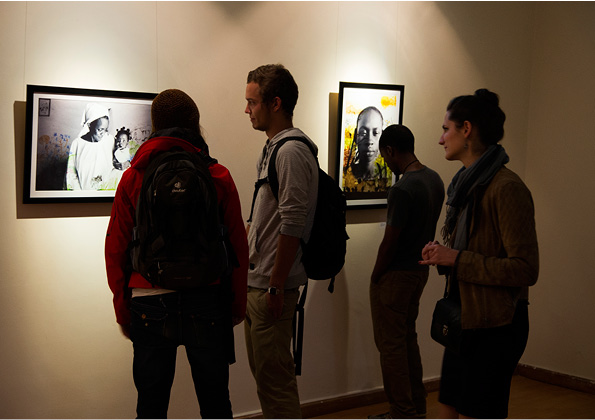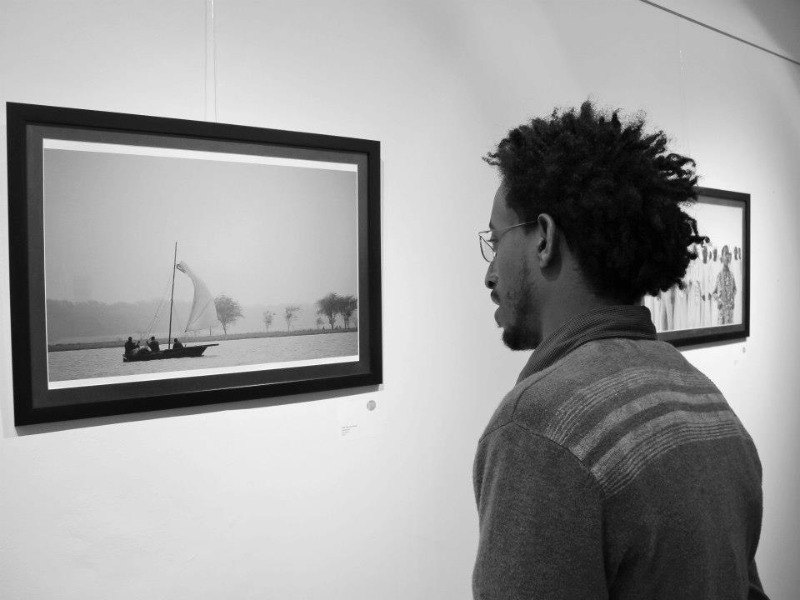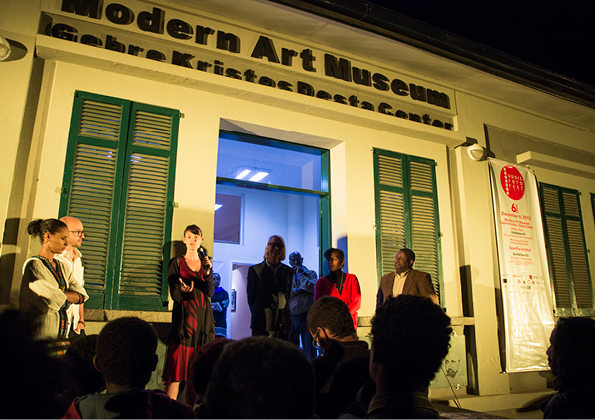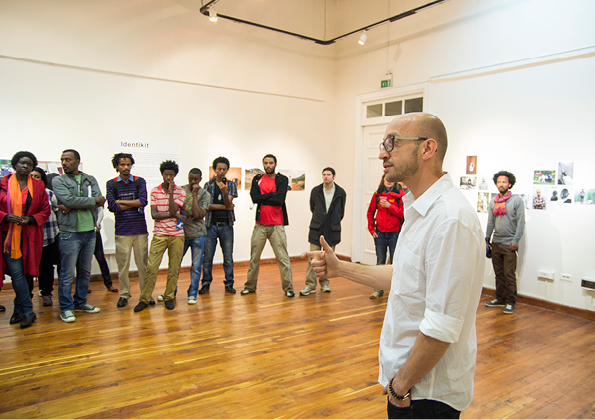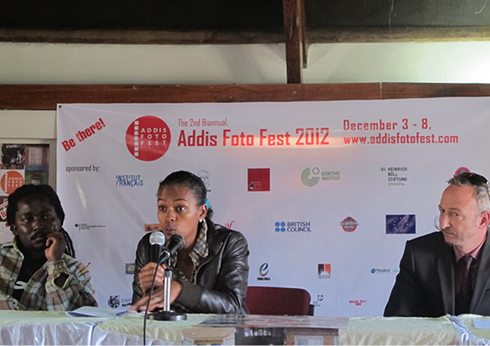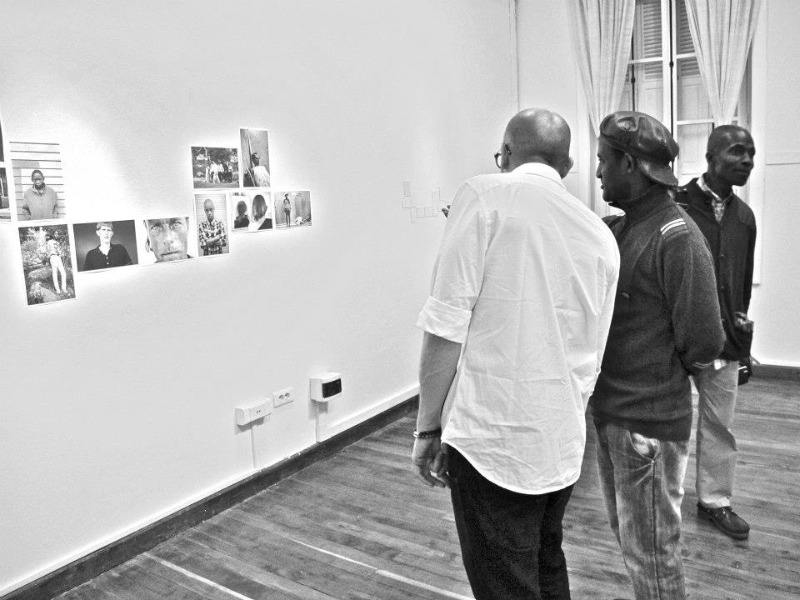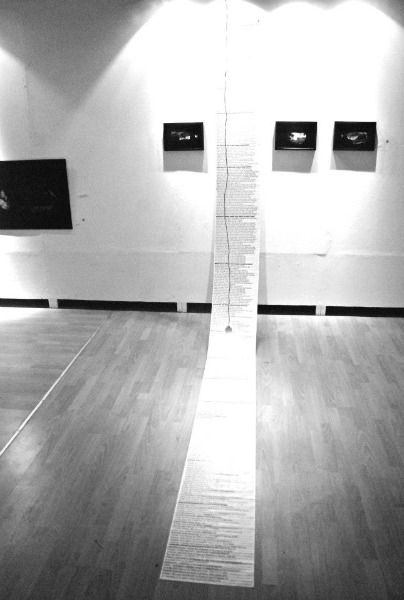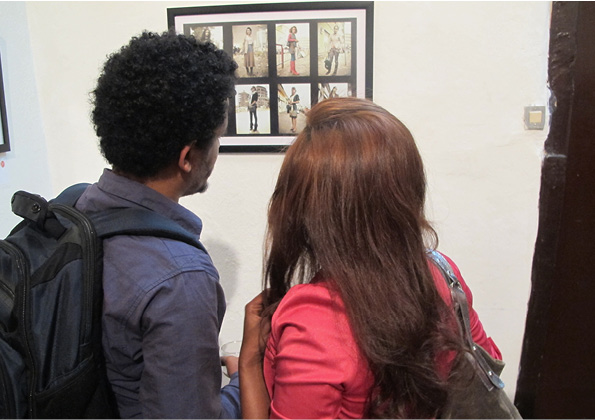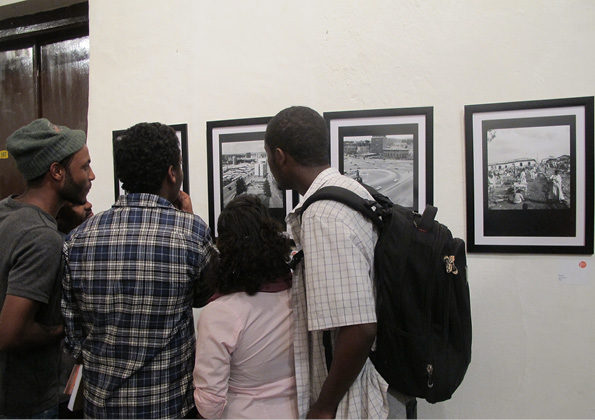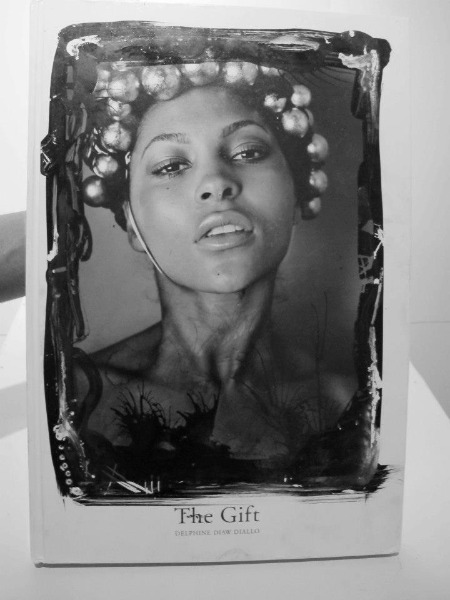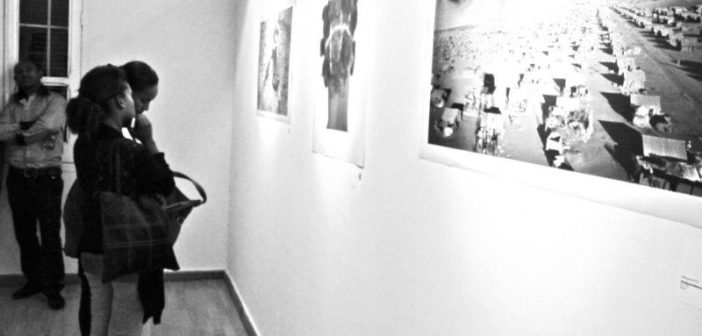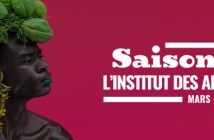Following the enthusiastic reports and echoes of the first edition of this biennial held in 2010 (1), followers of the African photographic scene were excitedly looking forward its second edition, which took place from December 3-8 2012 in Addis Ababa.
Over and above this excitement and a dense program comprising of a succession of very professionally led openings, talks, portfolios reviews and screenings, not to mention a highly dedicated and « on the ball » team, some questions could nonetheless be raised. For example, didn’t the exhibition devoted to the capital’s transformations (2) – a vast and vital topic for the rapidly growing city of Addis Abeba, organized on the occasion of the 125th anniversary of its creation (3) – deserve a much more extensive and in-depth treatment? In addition to the group show – part of which was the result of a six-month project -, the quality of which was variable and which only offered visitors a few glimpses into each photographer’s work, one wondered why more focus wasn’t placed on the historical photographs of Belete Tekele, presented by the organizers as « a photographer for the municipality of Addis Ababa », who worked for « numerous papers and magazines in the city », and whose career spanned over « three periods of Ethiopia’s political history » (4), yet less than ten of whose images were shown. It would have been fascinating to see the specific contexts in which these images were produced, and what the municipality’s remit was.
Moreover, given the pertinence of Ethiopian photographer Michael Tsegaye’s work and his ongoing and consistent project focusing precisely on these urban transformations, his absence in the show was regrettable. We hope, then, that this crucial burgeoning subject, common today to many other cities in Africa, will find extensions in the near future and that Mr Belete Tekele will be offered an appropriated frame to display and properly consider what appeared to be highly interesting documentary work.
These questions notwithstanding, it must be pointed out that the quality of the exhibition displays that I visited – the already mentioned Addis Transformation at the historic Taitu Hotel, Delphine Diaw Diallo and Marie Ange Bordas’ works at the Modern Art Museum/Gebre Kristos Desta Center, the « Market Photo Workshop » at the Goethe Institute, Ala Kheir’s show at the Italian Cultural Center (5) – was remarkable. At Delphine Daw Diallo’s show, a copy of the book she published herself – The Gift (6) – was also on view to the public. With its « immoderate » size and imposed forceful portraits, the ensemble released a stunning energy. In the nearby space, Marie Ange Bordas offered meditations on the theme of exile and migration through photographs and installations, which included a poignant timeline detailing all the reported deaths of men and women trying to penetrate Fortress Europe (7). Although I felt a similar feeling of frustration and incompleteness due to the too brief glimpses given of some fascinating works realized by students and alumni of the renowned South African school of photography, gathered into the Identikit show, a common thread running between them was palpable; most of the works dealt or started with a conceptual research, and perfectly framed the show’s central premises: « how the photograph as object should be considered not simply for its subject matter, but also for its own powers of representation as a medium » (8). Finally, to end this survey of the exhibitions visited, without prejudging perfectly framed and composed views of Khartoum, one could question what points of view and particular visions of this space the photographer Ala Kheir wanted to share through his work.
Even though I was unable to attend the panel discussion between Elvira Dyangani Ose, Michket Krifa and Marina Reina on the « photography market in Africa », I was lucky enough to follow an exciting round-table on « photojournalism and media in Africa », moderated with sensitivity by photographer Akinbode Akinbiyi. John Fleetwood, director of the Market Photo Workshop in Johannesburg, excellently introduced the produced and ongoing works, the programs and educational aims, and the functioning and history of the school, while the English photographer Nick Danziger passionately retraced his own career all over the world. Both presentations eclipsed that of Frédéric Lafargue, the ex-Gamma agency photographer, who simply in a few words introduced a slide-show of images taken in Iraq (recently shown at the Perpignan photojournalist festival) and made even more dramatic and « spectacular » by his sound editing. Unlike the others, it did not question the representational powers of the medium, which would have been particularly interesting, especially considering the media context for which these images were produced (not to mention the theme of the talk).
If I was so enthusiastic about John Fleetwood’s speech, it was because, to me, it held another pearl: the presentation of the Makweteng Heritage Project (9). This was run in and around Makweteng (a historical township which saw the first forced displacements of its black inhabitants), focusing on its heritage and living conditions, and where its communities were involved and invited to share their own personal memories. A vast quantity of written, photographic, video and oral documentation was thus gathered. This experience notably provided interesting grounds of reflection on how photographic essays might be structured to have a deeper impact at a local level; thus creating something tangible out of dispersed and often inaudible memories, and a vehicle to interrogate and reconnect with the past and present (which brings to mind the Addis Transformation exhibition…).
It thus appeared clear to me that it is precisely during the exchange of these experiences that the format of a « photography festival in Africa » – where the question of a consistent and critical public is crucial, and where, beyond a small circle of photographers and amateurs, many still work hard to convince of the interest of documentary and artistic photography – can draw all its force and meaning. And that beyond exhibitions, portfolio reviews and so on, these gatherings should perhaps put all their energy in trying to push the different creative ways in which both the medium and the festival moment can be constituted and invented locally.
Finally, it is worthy of note that this debate was attentively followed by an enthusiastic crowd of young people – the same was true of the opening shows (10) – and that, while linking its book program with a retrospective of part of its first edition (through interviews with different players, curators and photographers), the team has been attentive to its future.
How did the first edition of the festival impact on the 2012 edition, its directions and program? In other words, what did you learn from this first experience?
I was once told that it would be impossible to organize an event like the Addis Foto Fest and, amidst much scepticism – having given birth to my son only a few months ago -, the second edition was successfully completed. So, when you ask me what I have learnt, the one lesson that I take with me is that remaining persistent in what you believe is the key to realizing any endeavour.
Some artists attending this edition were already invited in 2010. This was the case, for example, with Nick Danziger, Akinbode Akinbiyi, Emeka Okereke and the Invisible Borders project. Can you please say few words about this choice?
In regards to Nick and Akinbode, these are individuals who I admire and respect for their dedication to teaching young photographers what they have learnt in their years of being in the field. As for Emeka’s Invisible Borders project, it was only logical to invite them to Addis Ababa since there aren’t many African collectives who are doing the work that they are doing.
What main ideas inspired you when selecting the program?
The main inspiration for me is photographers who have continually supported the development of photography on the continent, through their work. It is also a matter of continuing to work with individuals who have gone beyond their call of duty to support the Addis Foto Fest.
What were the main obstacles and difficulties that you and your team had to face while setting up the festival?
The challenges are enormous and I share this with the many grassroots culture activities that are taking place across Africa and which are initiated by African artists. We all have to deal with budget constraints, lack of proper staffing, lack of funding, egos and so forth. But my focus is not in the challenges but on the many possibilities of what has been accomplished and what the future holds for the Addis Foto Fest. Dynamics may change but the mission continues.
How would you describe that mission? And has it evolved since you first started working on this project?
Each edition is a learning process for me with regards to the collection, funding partners and also in the topics that I want to address in the editions. The shifting dynamics, and not only in Ethiopia, has been around conserving cultural funding for activities on the continent. My main goal is to create new partnerships and also to strengthen relations with African governments; it is about our own governments supporting the activities that take place here. I am a strong believer that culture plays a role in the discussion of development, hence we have to have our own governments and business people to become active in this realm.
What was festival’s budget? Are all the prints and frames produced in Addis Ababa?
The festival was produced with 25,000 euros. All the production was completed here in Addis Ababa. I am a believer in establishing and developing the photography industry locally, hence the intention is to produce all the works locally. Yes, of course, sometimes the quality isn’t 100%, but at least over the years we can establish Addis Ababa as a central place in Africa for producing quality images.
From the first to the second edition, have you seen a local community of photographers or photography professionals and those interested in photography growing, exchanging and creating new joint projects?
Yes, of course. My main interest is not to open shows for the elite, it is about the people, hence, to see an audience of new faces at each opening, especially mostly young ones, is a sign for me that I am attracting a segment of the population that will learn from the collection that I am showing.
As the director of the festival, what is your assessment of the 2012 AFF? And what perspectives, ideas and paths do you see for the next edition?
The future is boundless with many possibilities and I am grateful for those who believed enough to take part in the second edition.
Artist Jimmy Ogonga came to Addis from Nairobi as a guest co-curator for the festival. Do you see possible regional dynamics in the future?
We have worked together in the past and I think, since there are more and more cultural activities taking place on the continent that are initiated by artists from Africa, that it is crucial to our success to continue collaborating and working together.
(1) See, for example, « Annotations à propos de l’Addis Foto Fest 2010 », by Laurent Lafuma:
//africultures.com/php/index.php?nav=article&no=10822
(2) This exhibition was entitled Addis Transformation: Urbanization, Society and The Environment in Addis Ababa.
A lecture entitled « Addis Ababa: The Enigma of the’New’ and the’Modern' » by architect Elias Yitbarek and art historian and critic Elisabeth Wolde Giorgis, held at the Goethe e Addis Ababa on April 4 2013, questioned the topic of the city’s massive transformations through the work of artists working on them. The press release explained that it « precedes a planned exhibition of the same title to be organized by the Modern Art Museum Gebre Kirstos Desta Center, the Alle School of Fine Art and Design and the Institute of Architecture, Building Construction and City Development (EIABC). by Dr. Elisabeth W/Giorgis & Dr. Elias Yitbarek, AAU.
(3) The construction of Menelik II’s gebbi – seat of the royal power – in what became the new capital of Addis Ababa, was undertaken between 1887 and 1897.
(4) Excerpts from the festival catalogue.
(5) The other exhibitions held included the Invisible Borders exhibition at the Africa Union New Conference Centre, Africa.es: 8 African Photographers’ views of Spain at the National Theater Gallery, while the scheduled African Emerging Photography (a selection from the 2011 Bamako biennial), lost in the Ethiopian cargo hangars during the festival, was launched on January 2013.
(6) Excerpts of this work are displayed on her website, see: http://thegiftartbook.tumblr.com/
(7) According to this list, compiled since 1993 by UNITED, the European Network against Racism, Fascism and in Support of Migrants and Refugees (http://www.unitedagainstracism.org, more than 16,136 deaths have been documented up to now (the « Fortress Europe » blog points out that at least 18,567 people have died since 1988 along the European borders: http://fortresseurope.blogspot.fr/2006/02/immigrants-dead-at-frontiers-of-europe_16.html). Marie Ange Bordas first used this list in her photo-video installation entitled Donate (see: http://www.marieangebordas.com/).
(8) Excerpt from the introductory text introducing.
(9) See: http://www.marketphotoworkshop.co.za/projects/entry/makweteng-heritage-project
(10) See, for instance, the video at the opening of Addis Transformation:
http://www.facebook.com/photo.php?v=309258142522684&set=vb.227490517366114&type=2&theater
– the Addis Foto Fest’s website: http://www.addisfotofest.com/
– the Addis Foto Fest’s Facebook page: http://www.facebook.com/addisfotofest?ref=ts&fref=ts
Other reviews on the festival:
– Addis journal, 5 December 2012:
Addis Photo Fest underway
– Capital, 10 December 2012:
http://www.capitalethiopia.com/index.php option=com_content&view=article&id=2123%3Aaddis-foto-fest-delivers&catid=44%3Aarts-and-culture&Itemid=50///Article N° : 11453
